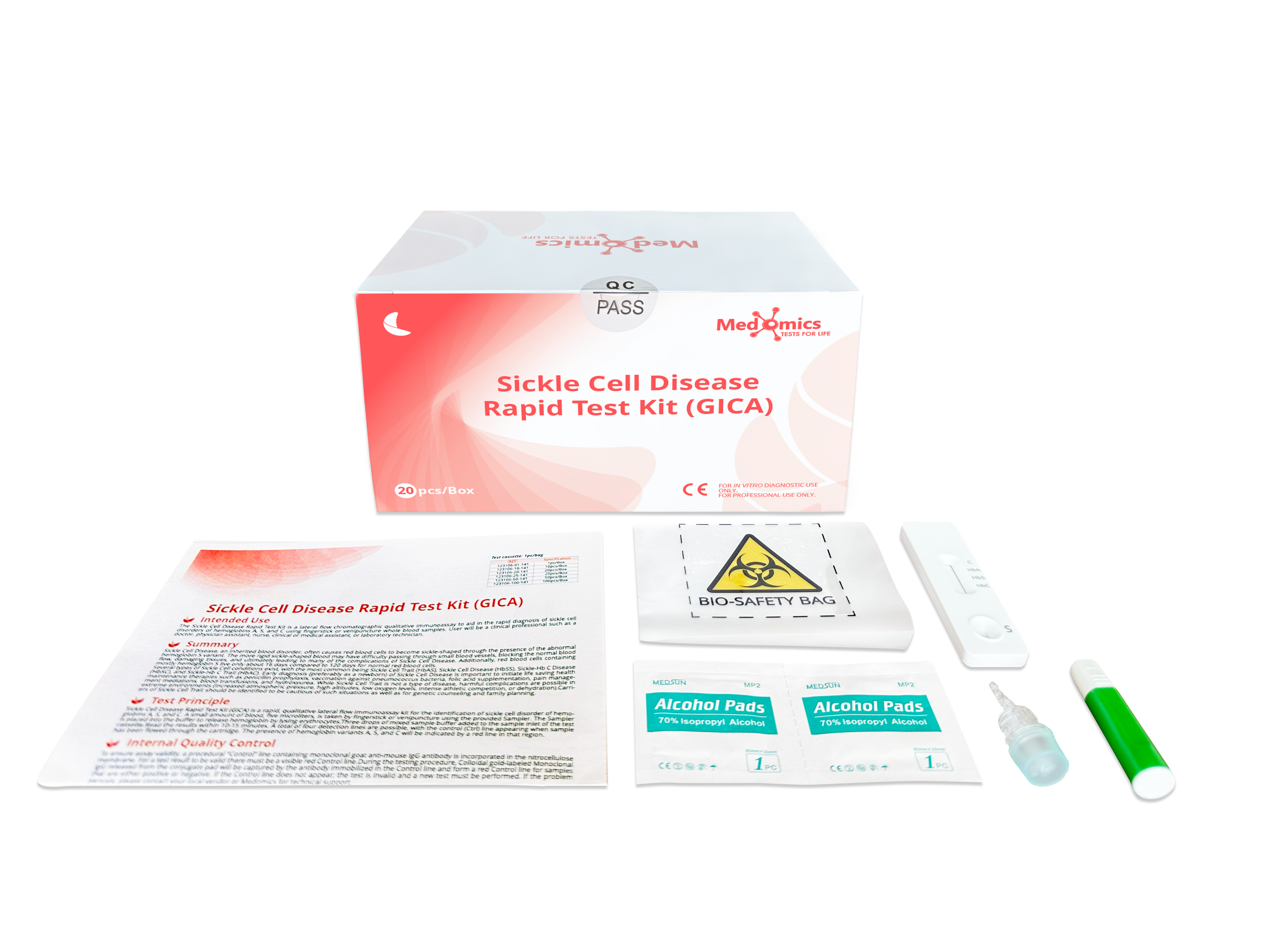Overview of Sickle Cells Diseases and Introduction of a Cost-Effective Rapid Diagnostics Test
- Categories:Newsroom
- Author:
- Origin:
- Time of issue:2023-11-08
- Views:0
(Summary description)Sickle cell disease (SCD), a group of related ß-hemoglobinopathies, is characterized by the predominance of sickle hemoglobin within patients’ red blood cells.
Overview of Sickle Cells Diseases and Introduction of a Cost-Effective Rapid Diagnostics Test
(Summary description)Sickle cell disease (SCD), a group of related ß-hemoglobinopathies, is characterized by the predominance of sickle hemoglobin within patients’ red blood cells.
- Categories:Newsroom
- Author:
- Origin:
- Time of issue:2023-11-08
- Views:0
The number of people living with sickle cell disease globally increased by 41·4% from 5·46 million to 7·74 million between 2000 and 2021. During the same period, total births of babies with sickle cell disease increased by 13·7%, to 515,000, primarily due to population in the Caribbean and western/central sub-Saharan Africa. It was estimated that the total sickle cell disease mortality burden was at 376,000, whereas among children younger than 5 years the mortality burden was at 81,100 deaths. Data gaps and high uncertainty in the estimates demand the urgent needs for routine and sustained surveillance and diagnostic tests, in order to further research assessing the contribution of disease conditions, and evidence-based prevention and treatment strategies. Sickle cell disease (SCD), a group of related ß-hemoglobinopathies, is characterized by the predominance of sickle hemoglobin within patients’ red blood cells. A single nucleotide mutation in ß-globin gene results in a ß-globin protein (HbS) with a hydrophobic valine, instead of a hydrophilic glutamic acid at the sixth amino acid position. HbS is susceptible to polymerization upon deoxygenation, and this property underlies all the pathophysiology of SCD. Erythrocytes become dehydrated, inflexible, and abnormally adhesive and have a shortened lifespan. As a result, a chronic hemolytic anemia, with intravascular and extravascular components, and a tendency for microvascular obstruction or vasoocclusion.
Sickle cell disease (SCD), a group of related ß-hemoglobinopathies, is characterized by the predominance of sickle hemoglobin within patients’ red blood cells. A single nucleotide mutation in ß-globin gene results in a ß-globin protein (HbS) with a hydrophobic valine, instead of a hydrophilic glutamic acid at the sixth amino acid position. HbS is susceptible to polymerization upon deoxygenation, and this property underlies all the pathophysiology of SCD. Erythrocytes become dehydrated, inflexible, and abnormally adhesive and have a shortened lifespan. As a result, a chronic hemolytic anemia, with intravascular and extravascular components, and a tendency for microvascular obstruction or vasoocclusion.
SCD includes a number of different diseases (Table 1). The most common and severe form of SCD is the homozygous state called sickle cell anemia (HbSS). Red blood cells containing mostly hemoglobin S live only about 16 days compared to 120 days for normal red blood cells. Several types of Sickle Cell conditions exist, with the most common being Sickle Cell Trait (HbAS), Sickle Cell Disease (HbSS), Sickle-Hb C Disease (HbSC), and Sickle-Hb C Trait (HbAC).
Survival with SCD has improved over the past half-century, due to early detection, preventive measures, and disease-modifying therapies (e.g. hydroxyurea and chronic transfusions), SCD was considered a fatal disease of children, but it has become a chronic disease, with contemporary multidisciplinary cares in experienced centers in highly-resourced nations, Nearly all children are expected to survive to adulthood. However, this is not the case for under-resourced nations and regions.
Early diagnosis (preferably as a newborn) of Sickle Cell Disease is important to initiate life saving health maintenance therapies such as penicillin prophylaxis, vaccination against pneumococcus bacteria, folic acid supplementation, pain management mediations, blood transfusions, and hydroxyurea. While Sickle Cell Trait is not a type of disease, harmful complications are possible in extreme environments/conditions (increased atmospheric pressure, high altitudes, low oxygen levels, intense athletic competition, or dehydration). Carriers of Sickle Cell Trait should be identified to be cautious of such situations, as well as for genetic counseling and family planning.
Several different methods are used to diagnose SCD. The most common methods are hemoglobin electrophoresis, high performance liquid chromatography (HPLC), isoelectric focusing, and molecular approaches, such as PCR. However, all require trained staffs working with specialized equipment in highly-resourced laboratory facilities, Solubility testing is a common and cheaper alternative to other diagnostic tests, but the solubility test has very low sensitivity, labor-intensive, and only detects patients with HbSS; confirmatory lab tests are still required.
Medomics’ “Sickle Cell Disease Rapid Test Kit” is a lateral flow chromatographic qualitative immunoassay to aid in the rapid diagnosis of sickle cell disorders of hemoglobins A, S, and C, using fingerstick or venipuncture whole blood samples. Professional users are recommended to use the product, such as clinical doctors, physician assistants, nurses, clinical or medical assistants, or laboratory technicians. A small amount of blood, five microliters, is taken by fingerstick or venipuncture using the provided Sampler. The Sampler is placed into the buffer to release hemoglobin by lysing erythrocytes.Three drops of mixed sample buffer added to the sample inlet of the test cassette. Read the results within 10-15 minutes. A total of four detection lines are possible, with the control (Ctrl) line appearing when sample has been flowed through the cartridge. The presence of hemoglobin variants A, S, and C will be indicated by a red line in that region.
Table 1. Overall SCD disease severity and typical hematologic features

Adopted from Quinn, CT.

References
1. GBD 2021 Sickle Cell Disease Collaborators (2023). Global, regional, and national prevalence and mortality burden of sickle cell disease, 2000–2021: a systematic analysis from the Global Burden of Disease Study 2021. Lancet Haematol 2023; 10: e585–99, Published Online June 15, 2023, https://doi.org/10.1016/S2352-3026(23)00118-7
2. Quinn, C.T. (2016). Minireview: Clinical severity in sickle cell disease: the challenges of definition and prognostication. Exp Biol Med (Maywood). 2016 Apr; 241(7): 679–688. Published online 2016 Mar 23. doi: 10.1177/1535370216640385
3. McGann, P.T., Schaefer, B.A., Paniagua, M., Howard, T.A., & Ware, R.Elliott. (2016). Characteristics of a rapid, point-of-care lateral flow immunoassay for the diagnosis of sickle cell disease. American Journal of Hematology, 91(2), 205 - 210.
4. Williams, T.N. (2015). An accurate and affordable test for the rapid diagnosis of sickle cell disease could revolutionize the outlook for affected children born in resource-limited settings. BMC Medicine, 13(1), 238.
5. Kanter, J., Telen, M.J., Hoppe, C., Roberts, C.L., Kim, J.S., & Yang, X. (2015). Validation of a novel point-of-care testing device for sickle cell disease . BMC Medicine, 13(1), 225.
6. Okwi, A.L., Byarugaba, W., Parkes, A., & Ocaido, M. (2010). The reliability of sickling and solubility tests and peripheral blood film method for sickle cell disease screening at district health centers in Uganda. Clinics in Mother and Child Health, 7(1)
Scan the QR code to read on your phone
- Email Us overseas@medomics-dx.com
- Call Us +86-025-58601060
- COVID-19 Solution
- Top
Contact Us
Phone: (+86) 025 - 58601060
E-mail: overseas@medomics-dx.com
Address:Building 01, Phase 6, No.71, Xinghui Road, Jiangbei New Area, Nanjing
- Email Us
- COVID-19 Solution
- Call Us (+86) 025 - 58601060
- top
Jiangsu Medomics Medical Technology Co,Ltd Powered By www.300.cn










